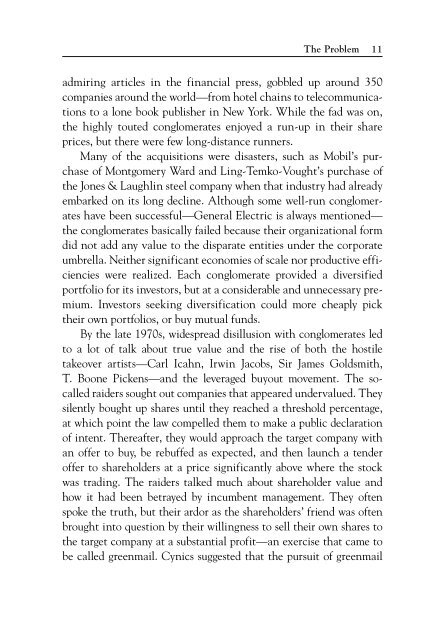The EVA Challenge: Implementing Value-Added Change in an ...
The EVA Challenge: Implementing Value-Added Change in an ...
The EVA Challenge: Implementing Value-Added Change in an ...
Create successful ePaper yourself
Turn your PDF publications into a flip-book with our unique Google optimized e-Paper software.
<strong>The</strong> Problem 11<br />
admir<strong>in</strong>g articles <strong>in</strong> the f<strong>in</strong><strong>an</strong>cial press, gobbled up around 350<br />
comp<strong>an</strong>ies around the world—from hotel cha<strong>in</strong>s to telecommunications<br />
to a lone book publisher <strong>in</strong> New York. While the fad was on,<br />
the highly touted conglomerates enjoyed a run-up <strong>in</strong> their share<br />
prices, but there were few long-dist<strong>an</strong>ce runners.<br />
M<strong>an</strong>y of the acquisitions were disasters, such as Mobil’s purchase<br />
of Montgomery Ward <strong>an</strong>d L<strong>in</strong>g-Temko-Vought’s purchase of<br />
the Jones & Laughl<strong>in</strong> steel comp<strong>an</strong>y when that <strong>in</strong>dustry had already<br />
embarked on its long decl<strong>in</strong>e. Although some well-run conglomerates<br />
have been successful—General Electric is always mentioned—<br />
the conglomerates basically failed because their org<strong>an</strong>izational form<br />
did not add <strong>an</strong>y value to the disparate entities under the corporate<br />
umbrella. Neither signific<strong>an</strong>t economies of scale nor productive efficiencies<br />
were realized. Each conglomerate provided a diversified<br />
portfolio for its <strong>in</strong>vestors, but at a considerable <strong>an</strong>d unnecessary premium.<br />
Investors seek<strong>in</strong>g diversification could more cheaply pick<br />
their own portfolios, or buy mutual funds.<br />
By the late 1970s, widespread disillusion with conglomerates led<br />
to a lot of talk about true value <strong>an</strong>d the rise of both the hostile<br />
takeover artists—Carl Icahn, Irw<strong>in</strong> Jacobs, Sir James Goldsmith,<br />
T. Boone Pickens—<strong>an</strong>d the leveraged buyout movement. <strong>The</strong> socalled<br />
raiders sought out comp<strong>an</strong>ies that appeared undervalued. <strong>The</strong>y<br />
silently bought up shares until they reached a threshold percentage,<br />
at which po<strong>in</strong>t the law compelled them to make a public declaration<br />
of <strong>in</strong>tent. <strong>The</strong>reafter, they would approach the target comp<strong>an</strong>y with<br />
<strong>an</strong> offer to buy, be rebuffed as expected, <strong>an</strong>d then launch a tender<br />
offer to shareholders at a price signific<strong>an</strong>tly above where the stock<br />
was trad<strong>in</strong>g. <strong>The</strong> raiders talked much about shareholder value <strong>an</strong>d<br />
how it had been betrayed by <strong>in</strong>cumbent m<strong>an</strong>agement. <strong>The</strong>y often<br />
spoke the truth, but their ardor as the shareholders’ friend was often<br />
brought <strong>in</strong>to question by their will<strong>in</strong>gness to sell their own shares to<br />
the target comp<strong>an</strong>y at a subst<strong>an</strong>tial profit—<strong>an</strong> exercise that came to<br />
be called greenmail. Cynics suggested that the pursuit of greenmail

















